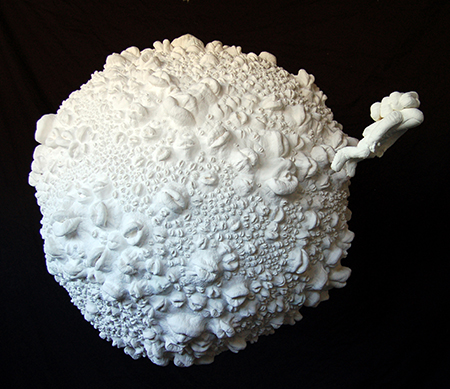
Continuing through March 11, 2016
They seem to be the oddest of odd couples in Los Angeles, a marriage of the sacred and the profane, the spirit and the body, sincerity and irony. But Patty Wickman’s deeply spiritual paintings are the necessary counterpart to Tim Hawkinson’s convoluted examinations of the corruptible human body — one cannot understand the purity of the soul without acknowledging the ungovernable flesh. Because Wickman is a painter whose works array themselves neatly and modestly on the gallery walls, while Hawkinson is an installation artist whose works tend to gobble up any proffered space, the underlying connection between this well-known couple is easily lost. But the oscillation between their polarities shows the conceptual inter-dependence between their twenty-year oeuvres. Despite revolving fads, each has stayed true to their proscribed course, as “Starting Off in the Same Direction” demonstrates.
It is difficult to be a religious artist in twenty-first century America and it is almost impossible to succeed as an artist who investigates the role of spirituality in contemporary life. Conversely, although it is hard to imagine devotional art in this most secular of cities, Los Angeles has been the right place for Wickman. She deliberately drains both the act of painting and its materiality of any untoward passion, making way for the pale-hued enigmatic images that emerge from her imagination and her life. This combination of the ordinary and the domestic can be seen in the group of paintings, "Forty Days.”
The “Forty Days” refer to Lent, a Catholic and Christian period of contemplation, prayer and fasting that is observed between Ash Wednesday and Easter. These are the last days of Jesus, incorporating his Temptation, Passion and Resurrection. For an observant Christian is not merely a period of deprivation and abstinence but also of activation of the spiritual side of an examined life. During forty days of “scrutiny,” Wickman seeks God through the meditative act of making a painting each day as an act of “engagement” with the holy. These small works, arranged on a grid, are not so much paintings as offerings of devotion in which the artist “stretches out” the “thin places” of the heart so that God can enter.
In direct contrast to these private works of self-scrutiny by his wife, Hawkinson presents a different part of the universe, elements of the earth and aspects of outer space. The earthly tree that rises from the gallery floor is cobbled together from human interventions to the integrity of the body of the tree itself. We cut them down to make our homes, fashion our furniture and to publish our books. We also have used branches to fashion weapons, such as arrows to which we once affixed arrowheads, elegantly shaped flints. The tree, or what’s left of it, spent its previous life as a “Christmas” tree, but it has been salvaged and, using ordinary materials (palm fronds, sunflower seeds, pine cones, and potatoes) Hawkinson turned this “Saint Sebastian" into a target. Crisped with cornhusks, the arrows have been shot back into the stripped trunk, re-acting as restored branches. The feathers for these arrows seem to be made of pages from our books, also traces of trees and are also reunited with the rightful owner, a straight and narrow tree.
In true Hawkinson fashion, there is a spectacular piece to delight and amaze the audience — “Moon with Astronaut,” a wandering white moon, rough and round, towing a tethered astronaut on its daily orbit of the earth. The astronaut, also painted white, is composed of hand parts, that is, of fingers. The thumb is the spaceman’s head and helmet, the arms and legs are the other fingers. Disembodied from the hand itself, the digits demonstrate a willingness to take on a new role, flexing joints to give the hapless space traveler some ability to confront the moon. But the moon itself presents little comfort for the finger man, for the orb is covered with mouths, open and closed, lips, pursed and parted, looking like suckers on a rolling octopus. The effect of the ensemble is both frightening and funny. Who are we to leap to a foreign body that warns us — shouts at us — not to approach? Will the moon consume the astronaut or are the two bodies in dialogue, perhaps seeking rapprochement?
There are no answers to this exhibition, only questions, which is, of course, the point. Viewers who seek out Wickman’s paintings are asked to contemplate the sacred scenes and to enter spiritually or mentally into the space she provides for them. The spectators who wander through Hawkinson’s strange floating worlds full of odd beings can only walk and wonder. These are not artists who provide or give, but rather demand and provoke.
Published Courtesy of ArtSceneCal ©2016
